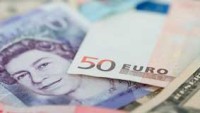 There is a concern that the recent improvement in the latest Chinese data could well have been a false dawn, and the recent April manufacturing PMI data would appear to reinforce that with this morning the latest Caixin manufacturing data for April showing a slow down to 49.4 from 49.7, following on from the official numbers at the weekend which slipped back to 50.1. With services also softening a little in April this could well be bad news for the commodity currencies which have seen a bit of a rebound of late.
There is a concern that the recent improvement in the latest Chinese data could well have been a false dawn, and the recent April manufacturing PMI data would appear to reinforce that with this morning the latest Caixin manufacturing data for April showing a slow down to 49.4 from 49.7, following on from the official numbers at the weekend which slipped back to 50.1. With services also softening a little in April this could well be bad news for the commodity currencies which have seen a bit of a rebound of late.
This rebound has caused a few concerns at the Reserve Bank of Australia which has seen the Aussie dollar jump higher in recent weeks and the subsequent slip back into deflation last week appears to have prompted the Australian central bank to cut rates further to a record low of 1.75% in response. While this was predicted in a number of circles the slide back into deflation is not too surprising given the recent declines in commodity prices in Q1. It also ignores the fact that these same prices have rebounded, which means that this may well have been a temporary phenomenon.
This, it would appear seems to have escaped the notice of the RBA as they become the latest in a long line of central bankers to adopt the reflex reaction function of cutting rates due to lower prices, ignoring the possibility that in some cases these can be a good thing.
While European stocks finished April on a bit of a sour note they still finished higher for the second month in succession. It is hard to escape the feeling though that the recovery seen since the February lows continues to be a rather half-hearted affair.
Since the all-time highs seen in the DAX and FTSE100 in April last year the direction of travel has been that of a slow decline, and while we just about remain in positive territory for 2016 sentiment towards European markets continues to be markedly cautious.
Contrast that with US stocks which while also below their peaks of last year, are a lot closer to their all-time peaks than European markets and have shown slightly more resilience, though that is probably more a result of the decline in the US dollar, than with any improvement in underlying fundamentals.
Yesterday saw the US dollar index hit its weakest level in over a year, and down over 7% from its 2015 peaks at 100.51.
This welcome US dollar weakness, which at the beginning of the year didn’t look very likely due to the widely held belief that the Federal Reserve was about to tighten policy aggressively, does appear to have largely extinguished a lot of concerns about the impact an ever rising US dollar might have had on the finances of a number of emerging economies.
Nonetheless while market expectations about the glide path of US rates have changed, the direction of travel of most recent US economic data has not, as it continues to show signs of economic weakness.
Yesterday’s April ISM manufacturing report followed on from last week’s weak regional PMI data, coming in at 50.8, below expectations of 51.5.
With the US consumer also showing fairly restrained behaviour and US Q1 GDP coming in weaker than expected, and last week’s surprisingly neutral Fed statement, the odds of a rate rise from next month’s June rate meeting continue to remain low, with now only a 12% probability of a rate rise getting priced into the market.
What makes this more surprising is the fact that the prices paid component of yesterday’s April ISM manufacturing report hit its highest level since September 2014 at 59, which could raise concerns that inflationary pressure could well be starting to work its way down the supply chain. This would have the potential to be the worst possible scenario for the Federal Reserve, if inflation starts to work its way through at precisely the time the US economy is starting to show signs of slowing.
This week’s US April jobs report, and in particular the wages data are likely to be key signposts in this particular debate.
In Europe yesterday’s manufacturing PMI’s showed some improvement on their March numbers with Italian and German activity showing an improvement in contrast to France which saw activity contract further in April to 48, from 49.6 in March. The French numbers are in contrast to the GDP numbers last week which showed that the French economy grew 0.5% in Q1, while the rest of the Eurozone economy outgrew, both the US and UK economies for the first time in a very long time, no doubt helped by the sharp fall in oil prices seen at the beginning of the year.
Today’s economic data is a little bit thinner on the ground with the main focus on the latest April manufacturing PMI data from the UK which is expected to show a small improvement to 51.2 from 51 in March.
The UK economy has proved to be a lot more resilient to some of the more colourful headlines in the ongoing “Brexit” debate with the pound among the best performers in recent weeks having finished higher for three weeks in a row against the US dollar.
Oh, and did someone mention that Leicester City won the Premier League title. Bloody brilliant!
EURUSD – the euro continues to push higher, rising above 1.1500 for the first time since August last year when it went as high as 1.1700. This becomes the next target, with a break targeting the 1.2000 area. Support comes in at the 1.1220 which if broken could see a move back towards the 1.1140 area, the lows at the end of March.
GBPUSD – having pushed through the 1.4650 level and come within a whisker of the 1.4700 area, the risk for further gains towards the 1.5000 level, has increased, but we could find the 1.4875 level a tough nut to crack initially being the 200 day MA. Dips look set to remain well supported with only break below 1.4300 undermining the bullish scenario.
EURGBP – having found support at the 0.7730 level we’re currently retracing some of the recent decline with resistance at 0.7865 and the 0.7930 level. While below 0.7930 the risk remains for a move back towards the 0.7690 area.
USDJPY – having finally reached the 106.00 area we could well see a rebound, but the route to 100.00 now seems open, if we push below the 106.00 level. To stabilise we would need to see a recovery back through the 107.80 area, which could well see a return to the 109.00 area.













